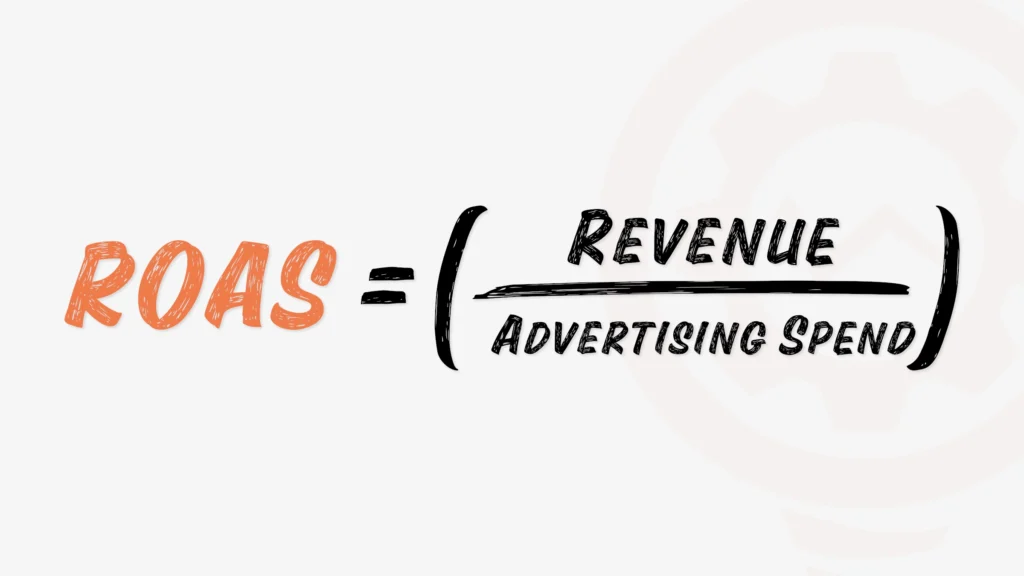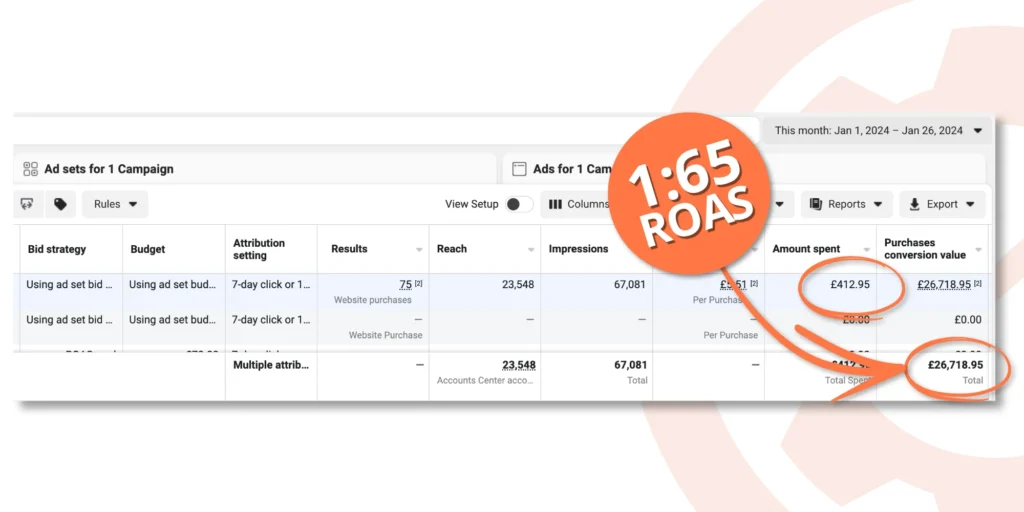
In our ongoing series dedicated to optimizing marketing returns, building on the insightful exploration of Return on Investment (ROI) and its tracking methods in Part 1, we now turn our focus to another fundamental metric: Return on Advertising Spend (ROAS). ROAS holds a crucial place in the marketing world, offering insights into the effectiveness of advertising endeavors. Unlike return on investment (ROI), which provides a broader financial perspective, ROAS serves as a guiding light specifically for assessing the effectiveness of advertising campaigns. Join us as we take a journey to uncover the meaning of ROAS and explore its significance, importance, and strategic implications for companies looking to improve their advertising performance.
Table of Contents
Definition of ROAS: What Is It and Why It Matters
Return on Advertising Spend (ROAS) is a critical metric that measures the effectiveness of advertising campaigns by assessing the revenue generated relative to the amount spent on advertising. Unlike ROI, which considers all costs associated with an investment, ROAS specifically focuses on the return generated from advertising expenditures.
ROAS is essential for several reasons:
- Performance Evaluation: ROAS provides insights into the performance of advertising campaigns, allowing businesses to assess the efficiency and effectiveness of their advertising investments.
- Resource Allocation: By analyzing ROAS across different advertising channels and campaigns, businesses can allocate resources strategically, investing in channels and strategies that deliver the highest returns.
- Budget Optimization: Understanding ROAS enables businesses to optimize their advertising budgets, reallocating funds to campaigns with higher ROAS and scaling back investments in less profitable channels.
- Decision Making: ROAS serves as a valuable tool for decision-making, guiding businesses in identifying opportunities for improvement, refining targeting strategies, and maximizing advertising ROI.
In essence, ROAS provides businesses with actionable insights that drive informed decision-making, leading to improved advertising performance and increased profitability.
ROAS Formula: How to Calculate It Correctly
The ROAS formula is relatively straightforward and involves dividing the revenue generated from advertising by the advertising spend:

How to calculate ROAS correctly:
- Revenue: This represents the total revenue generated from the advertising campaign. It includes sales, leads, or other conversions attributable to the campaign.
- Advertising Spend: This encompasses the total amount spent on advertising, including expenses such as ad placements, creative development, and campaign management fees.
By dividing the revenue by the advertising spend, businesses can determine the ROAS, which represents the amount of revenue generated for every dollar spent on advertising.
It’s important to note that ROAS is typically expressed as a ratio (e.g., 4:1), indicating that for every dollar spent on advertising, the campaign generated four dollars in revenue. This ratio provides a clear and standardized measure of advertising effectiveness, enabling businesses to compare ROAS across different campaigns and channels.
Understanding the ROAS formula empowers businesses to assess the performance of their advertising efforts accurately and make data-driven decisions to optimize their advertising strategies for maximum returns.
Target ROAS: Setting Your Goals for Optimal Performance
Setting a Target ROAS (Return on Advertising Spend) is crucial for guiding advertising strategies and maximizing campaign performance. By establishing clear objectives for ROAS, businesses can align their advertising efforts with overarching business goals and drive optimal results.
Steps to Setting Target ROAS
- Define Objectives: Clearly define your business objectives and how advertising contributes to achieving them. Whether it’s increasing sales, expanding market share, or improving brand awareness, ensure that your target ROAS aligns with these objectives.
- Analyze Historical Data: Evaluate past advertising performance and ROAS data to identify trends and benchmarks. Consider factors such as seasonality, campaign type, and audience segmentation to inform your target ROAS goals.
- Consider Margins and Costs: Take into account profit margins and advertising costs when setting target ROAS. Ensure that your target ROAS accounts for both revenue generation and profitability to maintain a sustainable advertising strategy.
- Segmentation and Optimization: Segment your advertising campaigns based on factors such as product categories, audience segments, and geographic regions. Set specific target ROAS goals for each segment and continuously optimize campaigns to achieve these targets.
- Monitor and Adjust: Regularly monitor advertising performance and ROAS metrics to track progress towards your target goals. Analyze campaign data, identify areas for improvement, and adjust strategies accordingly to optimize performance and maximize ROAS.
Setting Target ROAS goals provides a framework for optimizing advertising strategies, allocating resources effectively, and driving measurable results. By aligning advertising efforts with target ROAS objectives, businesses can maximize the efficiency and effectiveness of their advertising campaigns.
What Is a Good ROAS?
Determining what constitutes a “good” ROAS depends on various factors, including industry benchmarks, business objectives, and profit margins. While there is no universal benchmark for ROAS, several considerations can help evaluate the effectiveness of advertising campaigns:
- Industry Standards: Research industry-specific ROAS benchmarks to understand typical performance metrics for your sector. Compare your ROAS against industry averages to assess your advertising effectiveness relative to competitors.
- Business Goals: Align your ROAS goals with overarching business objectives. Consider factors such as revenue targets, profit margins, and return on investment to set realistic and meaningful ROAS targets.
- Profitability: Take into account profit margins and advertising costs when evaluating ROAS. A good ROAS should not only generate revenue but also contribute to overall profitability by maintaining healthy profit margins.
- Campaign Type and Objectives: Consider the type of advertising campaign and its specific objectives when assessing ROAS. For example, campaigns focused on brand awareness may have different ROAS targets than campaigns aimed at driving direct sales or conversions.
- ROI Considerations: Evaluate ROAS in conjunction with Return on Investment (ROI) to gain a comprehensive understanding of advertising performance. While ROAS focuses on revenue generated from advertising spend, ROI considers the overall profitability of the investment, including all associated costs.
By considering these factors and aligning ROAS goals with business objectives, businesses can establish meaningful benchmarks for evaluating advertising performance and optimizing return on advertising spend. Continuously monitoring and adjusting ROAS metrics enables businesses to refine advertising strategies, maximize campaign effectiveness, and drive sustainable growth.

ROAS in Different Advertising Platforms
ROAS in Google Ads
Google Ads is a powerful platform for reaching potential customers through targeted advertising campaigns. ROAS (Return on Advertising Spend) in Google Ads is a key metric that measures the effectiveness of advertising investments and helps businesses optimize their campaigns for maximum returns.
Calculating ROAS for Google Ads
Calculating ROAS for Google Ads involves analyzing the revenue generated from the campaign relative to the advertising spend. Here’s how to calculate ROAS for Google Ads:
- Determine the revenue generated from the advertising campaign. This includes sales, leads, or other conversions attributed to the campaign.
- Calculate the advertising spend associated with the campaign. This includes the total cost of running the ads, including ad placements, clicks, and any management fees.
- Divide the revenue by the advertising spend to calculate the ROAS.
By calculating ROAS for Google Ads, businesses can assess the efficiency and profitability of their advertising campaigns and make data-driven decisions to optimize performance.
Benchmarks for Google Ads ROAS
Benchmarking Google Ads ROAS involves comparing your campaign’s performance against industry standards and best practices. While ROAS benchmarks can vary depending on factors such as industry, business goals, and advertising strategies, here are some general benchmarks to consider:
- E-commerce: A typical ROAS benchmark for e-commerce businesses in Google Ads is often around 400% or higher. This means that for every dollar spent on advertising, the campaign generates at least $4 in revenue.
- Lead Generation: For lead generation campaigns, a good ROAS benchmark may range from 200% to 500% or more, depending on the industry and competition level. Higher-value leads may justify a higher ROAS target.
- Local Businesses: Local businesses may have lower ROAS benchmarks due to smaller target audiences and lower average transaction values. A ROAS of 200% to 300% may be considered successful for local businesses.
It’s essential to evaluate your Google Ads ROAS against your specific business objectives, industry benchmarks, and competition to determine the effectiveness of your advertising campaigns and identify opportunities for improvement.
By understanding how to set, calculate, and benchmark ROAS in Google Ads, businesses can optimize their advertising strategies, maximize return on investment, and achieve their advertising goals effectively.

ROAS in Facebook Ads
Facebook Ads is a popular advertising platform that offers extensive targeting options and diverse ad formats, making it a valuable tool for businesses to reach their target audience. Understanding ROAS (Return on Advertising Spend) in the context of Facebook Ads is essential for optimizing campaign performance and maximizing returns on investment.
Average ROAS for Facebook Ads
The average ROAS for Facebook Ads can vary depending on factors such as industry, campaign objectives, targeting, and ad creative. However, industry benchmarks and historical data can provide insights into typical ROAS ranges for Facebook Ads campaigns:
- E-commerce: The average ROAS for e-commerce businesses on Facebook Ads typically ranges from 300% to 800%. However, high-performing campaigns may achieve ROAS values well above this range, while others may fall below.
- Lead Generation: For lead generation campaigns, a good ROAS benchmark may range from 200% to 500% or higher. The actual ROAS may vary depending on factors such as lead quality and conversion rates.
- Local Businesses: Local businesses may have lower ROAS benchmarks compared to e-commerce or lead generation campaigns due to smaller target audiences and lower average transaction values. A ROAS of 200% to 400% may be considered successful for local businesses.
It’s important to note that these are general benchmarks, and actual ROAS values can vary significantly based on campaign performance, targeting effectiveness, and other factors specific to each business.
Strategies for Improving ROAS on Facebook
Improving ROAS on Facebook Ads requires a strategic approach that focuses on optimizing various aspects of your advertising campaigns. Here are some strategies to enhance ROAS on Facebook Ads:
- Audience Targeting: Refine your audience targeting to reach users who are most likely to convert. Utilize Facebook’s advanced targeting options, such as demographics, interests, behaviors, and custom audiences, to narrow down your audience and improve ad relevance.
- Ad Creative Optimization: Test different ad creatives, including images, videos, copy, and ad formats, to identify which resonate best with your target audience. Use compelling visuals, clear messaging, and strong calls-to-action to engage users and drive conversions.
- Ad Placement and Delivery Optimization: Experiment with different ad placements and delivery optimization settings to maximize campaign performance. Test various placements such as News Feed, Instagram, Audience Network, and Messenger to identify which yield the best results for your objectives.
- Ad Copy and Messaging: Craft persuasive ad copy and messaging that speaks directly to your target audience’s needs, pain points, and desires. Use language that resonates with your audience and clearly communicates the value proposition of your products or services.
- Conversion Tracking and Optimization: Implement Facebook Pixel and conversion tracking to monitor campaign performance and optimize for conversions. Analyze conversion data to identify high-performing audiences, ad sets, and creatives, and allocate budget accordingly to maximize ROAS.
- Budget Allocation and Bid Strategy: Allocate budget effectively across campaigns, ad sets, and ads based on their performance and ROAS potential. Consider implementing automated bidding strategies, such as Target ROAS or Cost Cap, to maximize return on investment while maintaining efficiency.
By implementing these strategies and continuously optimizing your Facebook Ads campaigns based on performance data and insights, you can improve ROAS, drive higher returns on advertising spend, and achieve your business objectives effectively.

Shtrack Success Stories: Achieving Remarkable ROAS Results
Meta Ads’ Remarkable 1:65 ROAS
Step into the world of Meta Ads and witness the remarkable achievement of a 1:65 return on ad spend (ROAS). In this case study, we share our journey of challenging conventional norms, meticulously optimizing costs, and ultimately delivering unprecedented success for our client. Explore the Meta Ads case study here to witness the extraordinary power of our strategies.
Google Ads Case Study: Achieving 16:1 ROAS
Embark on a journey through our Google Ads expertise and witness the precision that led to an exceptional 16:1 return on ad spend (ROAS). With an investment of $7,740, we generated a remarkable $126,000 in revenue, surpassing industry norms. Our strategic approach to PPC ensures that every advertising dollar spent translates into significant revenue, revolutionizing the landscape of digital advertising. Dive into the Google Ads case study here to discover the transformative impact of our strategies.
Maximize Your Sales Potential with Shtrack: Book a Free Consultation Today!
Ready to achieve remarkable ROAS results like our success stories? Discover how our digital marketing services can boost your business. Book a free consultation now to discuss your goals and objectives with our experts. No strings attached – just valuable insights to help you succeed.
15 minutes with our experts.

Enjoyed the article?
Elevate your business with our expert insights. Subscribe for valuable tips that make a difference!